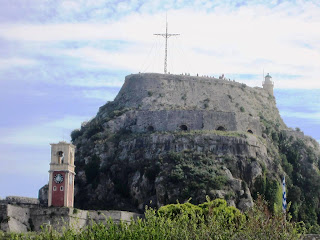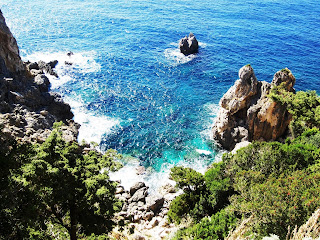 |
| Medieval architecture in the Marais |
One of the most impressive types of architecture in the Marais is what the French call a Hotel Particulier, a sumptuous city mansion built for aristocrats. A good example is Hotel du Sens, built in the
Middle Ages and once home to Queen Margot. Queen
Margot was both beautiful and brilliant, and she played a critical role in the
politics of 16th c. France. She was also known for having numerous
lovers and for being the daughter of Catherine de Medici, a nasty piece of work
who was fond of poisoning her enemies. (If you want to know more, watch the
movie “La Reine Margot,” available on
Netflix).
The Marais also contains Paris’s most famous Jewish
neighborhood. We happily ate our way along rue de Rosiers, also known as “Falafel
Street.” We ate the best falafel of our lives at neighborhood favorite L'As du Falafel. And scarfed down an
incredible pastrami pretzel sandwich at Florence Kahn’s.
 |
| Pastrami Pretzel sandwich at Florence Kahn's |
 |
| Well-equipped soldier guarding a Jewish school in the Marais |
As you know, we have a weakness for French chocolate. One of
the goals of our visit was to stock up on plenty of incredible dark Parisian
chocolate for the long, snowy Pocono winter. We
hit several of our favorite choco shops: Patrick Roger, Jean-Paul Hevin, and
Michel Cluizel. Thanks to our Parisian friend Martinn, we also discovered Alain Ducasse, who has a fine chocolate factory right in
the heart of Paris. When you visit his chocolate shop, you can actually watch
the chocolate being made on the other side of a glass window (unfortunately,
photos were not permitted).
 |
| Anne relishing her cup of hot choco at Angelina's |
Anne is a big Lafayette fan. What’s not to love? George Washington
treated Lafayette like a son, and many believe that we would never have won our
American Revolution without the assistance of the French, and specifically, our
greatest French supporter Lafayette. Anne
is also intrigued by the fact that Lafayette stayed in Bethlehem, PA where he
recuperated from a wound suffered at the Battle of Brandywine and may have had a romantic dalliance with a young Moravian woman named Liesl.
We paid our respects to the Marquis at his gravesite in the little known
Picpus Cemetery, the only remaining private cemetery in Paris. The cemetery was
created to honor the 1,306 victims who went to the guillotine during the summer
of 1794. Only relatives of the original guillotined victims may be buried in
this small cemetery. Sadly, the
grandmother, mother, and sister of Lafayette’s wife Adrienne were all
guillotined which is how he came to be buried here.
 |
| At Picpus Cemetery |
Lafayette loved America so much that he is buried under soil that he
brought from Bunker Hill. Yes, he's actually buried under genuine "American" soil. The site is
quite moving with many commemorative plaques from America including one from
the Daughters of the American Revolution and even one from Post 217 Easton, PA!
Anne stood there soaking it all in and whispered, “Lafayette, je suis ici.” (I
am here.)
Frank especially enjoyed our visit to the Curie Museum where Marie Curie
and her husband Pierre pioneered research in radium & radioactivity. The museum was very
low-key, but included an extensive collection of scientific instruments and
Marie’s former office and laboratory. Marie's presence was heavily felt everywhere here, as if she might come out and
greet us at any moment.
 |
| The Nobel Prize winning Curie Family - from left: Pierre & Marie Curie, Irene Joliot-Curie, and Fredric Joliot-Curie |
A short synopsis of their contribution shows that they both recognized that radium had almost "magical powers" in that it continuously emitted invisible radiation and gave off measurable heat. It was viewed by the Curies as potentially an inexhaustible source of energy. Altho Pierre Curie was killed in a horse cart accident in 1906, his wife, Polish-born Marie, continued experiments on radium and radon gas at the Curie Institute here in Paris for the rest of her life. In 1934, weak from many years of experiments with exposure to radiation poisoning, Marie succumbed to an inevitable demise.
We concluded the Curies were one remarkable family! We knew that Marie and Pierre had received a Nobel Prize in 1903, but Marie actually received a second Nobel Prize and is the only woman to be awarded this honor twice; also, she was the very 1st female, degreed physicist ever. We also didn’t realize that their daughter (Irene) and son-in-law (Fredric) received a Nobel Prize as well for research in chemistry. Yet another son-in-law, husband of Marie's eldest daughter, accepted a Nobel Peace Price for his work on UNICEF. Wow!! Five Nobel Prizes attributed to just one family. That's unheard of and had never happened before or since!!
 |
| Marie Curie's office |
Marie was not only a brilliant scientist; she was also a humanitarian who worked hard to foster collaboration with scientists from all around the world. She and Pierre never patented their discoveries believing that all life-saving knowledge should be shared.
Our Paris visit ended up being quite social. We met up with our friend
David who we first ran into on a bus tour in Croatia back in 2006. We have
stayed in touch over the years and were thrilled that our paths crossed once
again.
 |
| Our friend Martinn |
We also spent a special evening with Martinn, who rented us her apartment the last time we stayed in Paris. Martinn was kind enough to include Kay and Popat in our get-together, a California couple who were her current renters. Kay had contacted Anne via our blog many months ago and sent Anne an email asking for Paris apartment recommendations.
 |
| Martinn with our new friend, Kay |
Naturally, Anne recommended Martinn’s apartment, and now we were all together drinking wine here in Paris. Isn’t life grand?
We left Paris all too soon. There is always something more to see and do in this grand city. But then, we'll be back another time. Certainly, just as soon as the current stash of fine chocolate bars runs low!! Heh, heh.
























































